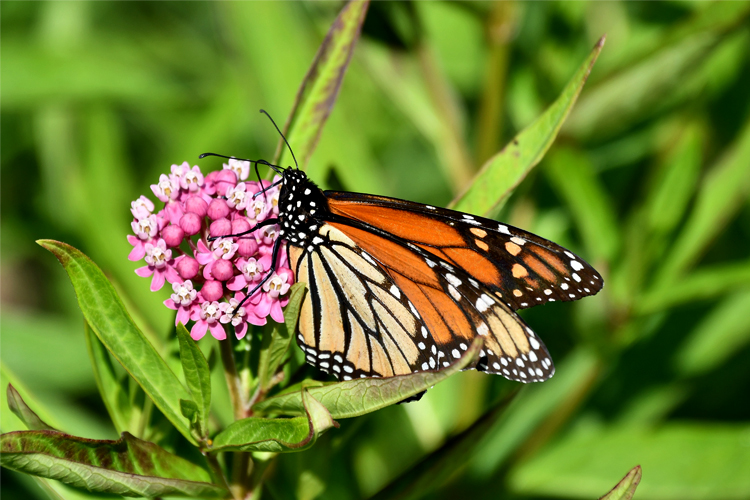By the time Micah Freedman was six years old, his favourite pastimes included collecting and categorizing coins, stamps and insects. Collecting and categorizing were skills that would lead to and serve him well in his career as a scientist.
“Both my parents are scientists,” says Freedman, who joined U of T in July 2024 as an assistant professor in the Faculty of Arts & Science’s Department of Ecology & Evolutionary Biology. “So from a very early age, science was a big part of growing up.
“I remember the field guides we had at home and becoming obsessed with a particular guidebook about insects. I would transcribe the descriptions of insects from the book to my notebook and use that to see if I could find those species outside. Collecting insects was definitely part of what sent me down the path I’m on today.”
Freedman’s research focuses on the relationships between insects and plants — in particular, Monarch butterflies and their strict diet of milkweed. He studies the genetic underpinnings of the relationship, how the butterflies sequester toxins from the plants, and what this close relationship reveals about the butterflies’ migration.
A&S News spoke to Freedman recently.
Why did you decide to join U of T?
To begin with, the Monarch butterfly summer breeding range includes the Great Lakes region, so Toronto’s a great place geographically to study this species. I can just step outside and there are butterflies right there.

Also, the Department of Ecology & Evolutionary Biology is a very well-regarded department with many highly respected researchers. In fact, there’s also a cool historical connection. Back in the 1960s and ‘70s, Fred and Norah Urquhart, who were affiliated with U of T Scarborough, started a program of tagging Monarch butterflies — this was before we had any idea that Monarchs were migrating or where they might be going. It was the Urquharts who discovered that the Monarchs, in fact, fly all the way to Mexico. At that point, no one knew. So it feels good to be here and be part of that legacy.
Why are you interested in Monarch butterflies in particular?
Monarch butterflies are a textbook example of an insect herbivore that's highly specialized in the plants they feed on. The Monarch larvae — caterpillars — feed exclusively on milkweed plants which are toxic to most species. And one hypothesis for why they are so specialized is that this diet makes Monarchs toxic to predators. The caterpillars sequester toxins from the milkweed they eat and store them in their tissue. Later, the butterfly contains the toxins, too. So, when a bird tries to eat a Monarch caterpillar or butterfly, it finds that its prey tastes extraordinarily bitter. The bird usually vomits and learns not to eat that kind of insect again.

So, I'm interested in the biology and the physiology of this process, and answering questions like: How is it that they're able to store these toxins in such high quantities? How does this interaction vary with different species of milkweed? And how is it related to migration?
Can you describe some of the research you and members of your lab will be conducting?
My PhD student, Adam Kai Chi Lee, is going to be working on the question of how the butterflies time their migration. He’s going to be studying the cues from the environment that they might be using to signal the start of their autumn migration. Every August and September, we see this big transition where the butterflies go from their summer reproductive and breeding period to a totally different physiological state when they migrate. We're interested in what triggers this transition. Is it cooler temperatures, shorter days or something about the plants in their diet?
How will you determine the answer to that question?
One of the series of experiments we'll be doing is to put butterflies in growth chambers in the lab, then manipulate those three environmental cues: temperature, light and food. This simulates the onset of autumn which is when their reproductive phase would end and they’d start to store fat for the long journey. Then, we’ll observe their inclination to fly south, either by simply releasing them and observing what direction they tend to take; or, while they’re contained and tethered in the lab, we can observe whether they tend to face or move southward.
You’re also chemically “fingerprinting” Monarchs. Can you explain what that is?

It’s similar to the way a crime lab works; but instead of using DNA to identify someone, we’re using a butterfly’s diet to identify its range. This works because the chemical fingerprint of milkweed species A is different than the chemical fingerprint of milkweed species B. We also know that each milkweed species has its own geographic range — from California to Mexico to Puerto Rico. Therefore, if you collect a butterfly and it has a chemical fingerprint that looks like milkweed species A, you know its migration route has to include the geographic range of milkweed species A.
So, a lot of the work I've been doing recently since getting to U of T is building a library of these chemical fingerprints. I raise Monarch caterpillars in a greenhouse with known species of milkweed for food which gives me the fingerprint for different milkweed species. Then, when I collect a wild butterfly, I can find the closest match in this library of known fingerprints and determine where it came from.
Do you have any advice for people wanting to see more Monarch butterflies in southern Ontario?
Monarchs are less common than they used to be, so my advice to people who want to see more of them and help them out is to be mindful of the kinds of plants you’re putting in your garden. You can plant milkweed, of course, but that’s just part of it. It’s also important to plant species of flowering plants that produce nectar which is the fuel for Monarch butterflies on their long-distance migration.

